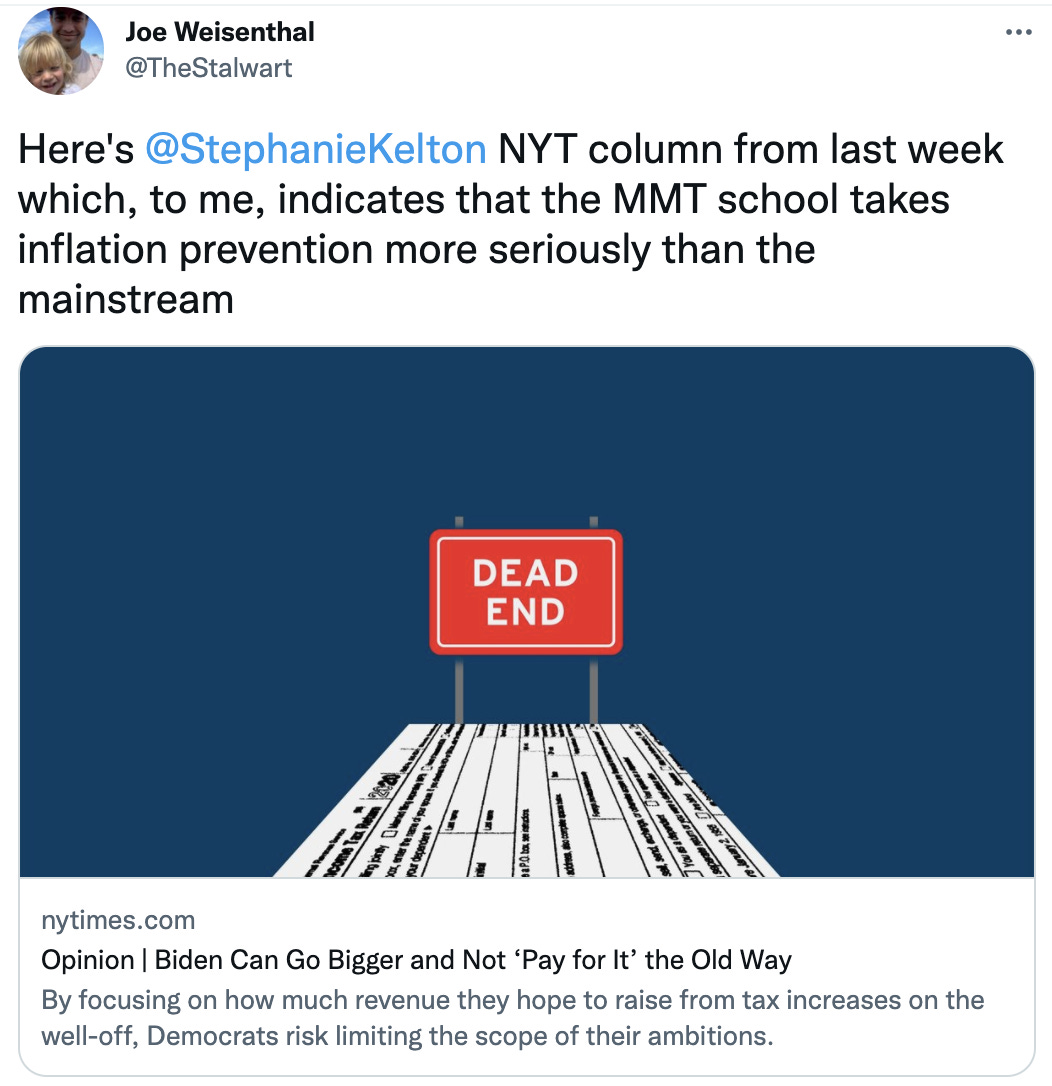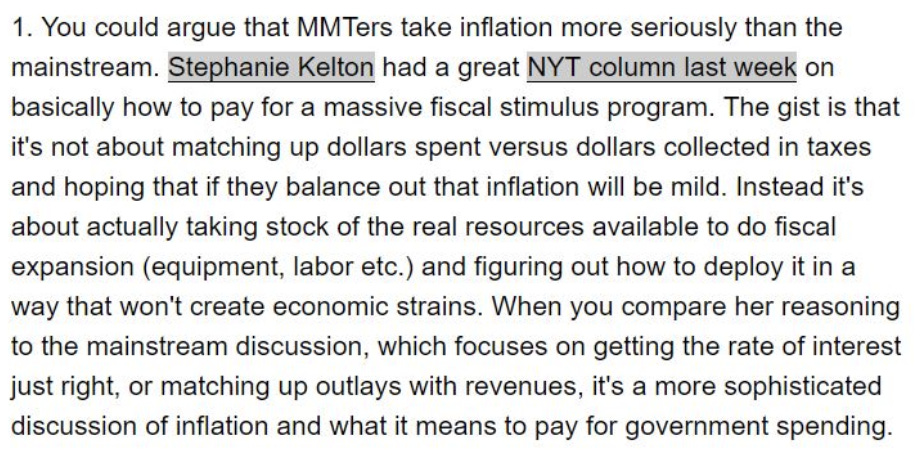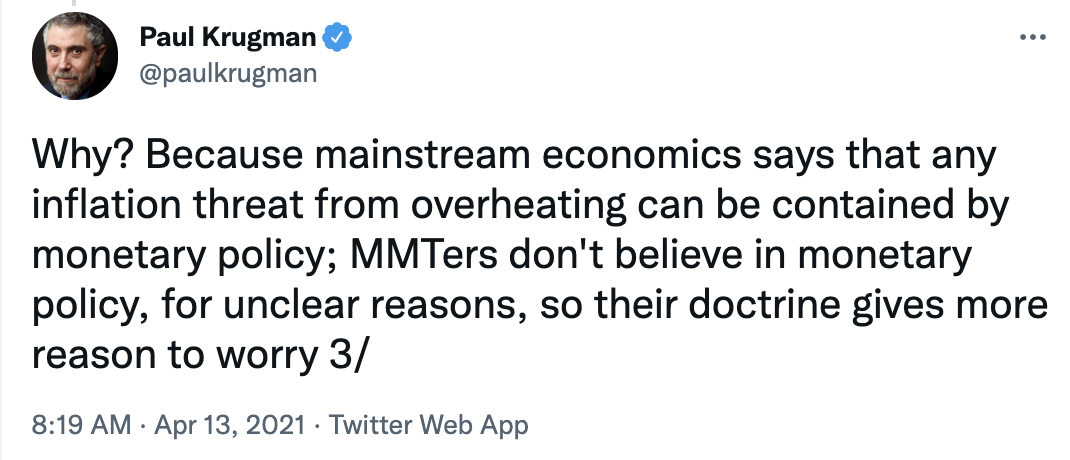In April of this year, I published a fairly long piece in The New York Times, arguing that Democrats should be thinking hard about how to roll out President Biden’s multi-trillion dollar Build Back Better agenda without exacerbating inflationary pressures. Unlike Larry Summers, who relentlessly blasted the $1.9 trillion American Rescue Plan, calling it the “least responsible” economic policy he’d seen in 40 years, I wasn’t trying to undermine the Biden administration’s spending proposals by warning that they risked setting off a serious burst of inflation.
That was never my view. Not only did I support the $1.9 trillion American Rescue Plan, which passed in spite of Larry’s efforts to tank it, I strongly supported (and still support) the $3.5 trillion reconciliation package. So, my column was not about leaning into the emerging narrative that it was time to start fretting over the possibility of an inflationary death spiral. I simply wanted to urge the White House and Congress to think early, often, and hard about how to deliver things like free college, universal pre-K, an expansion of Medicare, paid family/medical leave, climate investments, etc. in the face of emerging supply-chain disruptions, labor shortages, and other capacity challenges.
Here are some passages from that April 7, 2021 New York Times essay:
“The key to responsibly spending vast sums of money lies in carefully managing the economy’s real productive limitations.. .
Depending on how big Congress ultimately decides to go on infrastructure, and how quickly, it may need to unleash a whole suite of inflation-dampening policies along the way…
These mostly non-tax inflation offsets could include industrial policies, like much more aggressively increasing our domestic manufacturing capacity by steering investment back to U.S. shores, using even more ‘carrot’ incentives like direct federal procurement, grants and loans, as well as more ‘sticks’ like levying new taxes to discourage the offshoring of plants. Reforming trade policies is another option: Repealing tariffs would make it easier and cheaper for American businesses to buy supplies manufactured abroad and easier for consumers to spend more of their income on products made outside of our borders, draining off some domestic demand pressures.
The Biden team could also consider loosening its legal-immigration policies, so that even once America nears full employment there would still be an adequate labor pool to meet the increased demand for workers. Putting aside the obvious climate benefits of tightening environmental regulations, banning fracking on federal lands and offshore drilling in federal waters could free up people and materials for other activities. Health care reform could have a role too. (Significantly lowering the Medicare eligibility age would sharply reduce aggregate spending in the health care industry, a major source of price pressures in the economy.)
Over time, the Biden plan’s investments in our physical and human infrastructure will enhance our economy’s productive capacity, leaving us with a better educated and more productive work force, more efficient railways, less congested roadways, improved technologies and much else. But this can’t happen overnight. It will take years, and it might mean that we start to run out of available capacity as we go — especially if the House Progressive Caucus wins the addition of trillions more dollars. No one can predict exactly when, or across which industries, serious bottlenecks and other shortages might emerge.
That’s why to avoid short-run constraints like supply bottlenecks, the U.S. government can look elsewhere for capacity. American businesses can make use of depressed conditions abroad, buying from countries with economies that might be struggling to fully recover from the economic downturn and that will be more than happy to mutually benefit from our boom.
So it was unfortunate that in his long-awaited infrastructure speech, President Biden promised ‘not a contract will go out, that I control’ that isn’t for ‘a company that is an American company with American products, all the way down the line, and American workers.’
This ‘buy American’ philosophy is well intentioned but could lead to counterproductive trouble, particularly since the president has promised that ‘no one making under $400,000 will see their federal taxes go up’ — a pledge that takes raising taxes on the middle class, which has a higher marginal propensity to spend, off the table as a potential inflation offset.
A Biden-led plan that is overly protectionist is a much greater inflation threat than a plan that isn’t paid for in the traditional deficit-neutral budgetary sense. This framework — based on the principles of Modern Monetary Theory — redefines fiscal responsibility by flipping the age-old question ‘How will you pay for it?’ The real challenge is ‘How will you resource it?’”
The MMT lens keeps us focused on the things that matter. It’s not the headline dollar figure—$1.9 or $3.5 trillion—or the budgetary impacts of that spending that warrant our attention. What matters is the economy’s capacity to safely absorb those dollars as they begin to flow into people’s pockets.
After reading my column, Bloomberg’s Joe Weisenthal tweeted:
He elaborated in his popular newsletter:
Former White House economist, Jason Furman, read it differently, tweeting:
I wasn’t worried about “overheating” in the Team Larry sense that Congress had probably already pushed out too much stimulus by sending out $1,400 checks and extending enhanced unemployment benefits back in March. I was thinking through the next phase of the Biden administration’s spending proposals. And, yes, I was worried about the consequences of not thinking hard enough about how to embark on a wide-ranging, multi-trillion dollar spending program in the face of strengthening supply-chain headwinds. Jason’s response was, basically, “Don’t overthink it.”
It’s the typically cavalier way of thinking about inflation that has come to dominate mainstream economics. Keeping a lid on inflation is the central bank’s job, not something Congress, the White House, or anyone else really needs to waste time thinking about. If inflation accelerates above some desired target, the Fed will knock it back down by tightening monetary policy. Easy peasy. (Unless, of course, the Fed “falls behind the curve,” allowing “inflation expectations to become unanchored” and other mumbo-jumbo.)
All you really need is an “independent” central bank that is deemed “credible” by market participants, and you can sit back and relax. There’s a one-size-fits-all way to deal with any inflation problem. To dial inflation down, simply dial up the overnight interest rate. You might throw in some “forward guidance” to help shape “inflation expectations” but that’s really still about managing inflation via adjustments in the short-term interest rate.
It’s considered acceptable to challenge the central bank’s reaction function—e.g. to complain that the Fed is “falling behind the curve.” But it’s considered heretical to challenge the premise that monetary policy is the true and only savior when it comes to delivering us from inflation.
Here’s what Nobel laureate Paul Krugman had to say after my New York Times piece encouraged us to think harder about how to deal with emerging inflationary pressures.
It’s this sort of cavalier attitude and reverence for monetary policy that troubles me. We’re supposed to accept—as a matter of faith—that the central bank can always handle any inflation problem because mainstream economics says so?
It’s not that MMTers don’t “believe in monetary policy” (whatever that means). It’s that we believe it’s unrealistic to think that the central bank can steer our colossal macro ship by periodically nudging the overnight interest rate around in search of alignment with some mythical r*. It’s that we agree with former Fed governor Daniel Tarullo, who candidly professed that “the Fed has no reliable theory of inflation.” It’s that we share Jeremy Rudd’s skepticism about the role of “inflation expectations” as driver of actual inflation, and we question the very idea that rate hikes necessarily mitigate inflationary pressures.
Collectively, MMT economists have published hundreds if not thousands of pages outlining the reasons for our skepticism. So, our thinking would be unclear only to those who have not engaged with that literature.
Anyway, I’m glad to see that the White House isn’t just thinking harder about inflation but actually doing things to help ease supply-chain bottlenecks. It’s definitely time to start thinking outside the inflation (black) box.1








I remember economics in college, I had a book by neoclassical Blinder and one by neoclassical Mankiw. Both talked of economics as a way of studying and optimizing the allocation of resources. And now twenty years later I see these same neoclassicals refusing to engage with that very question. They never want to talk about real resources. All they know is interest rates and monetary policy.
How are such demonstrably incompetent people given such prominent platforms?
Kepler has given us his Laws of Planetary Motion but these Ptolemaics INSIST the sun orbits the earth.
When will these fools retire and go away?
I've been thinking a lot about this article the last three days because inflation is everywhere as a topic (and this is without watching TV). Even in conversation with friends and family it's come up, one person talking about the high price of meat, another friend wondering if she should travel now or in the spring because she doesn't know if flight prices will rise too much.
The more I think about this the more I'm convinced of the value of changing framing of economic questions, which MMT economists have been steadily doing for twenty-five years. And it's easy to do. When someone complains about inflation I've begun to say, "Don't you want your house's property value to go up? That's inflation too." It's like Professor Kelton's anecdote about asking people in that Senate committee's staff who want to get rid of government debt if they want to get rid of all government bonds.
The inflation question is probably one of the easiest ways of getting people to reframe their thinking, to use a different lens, as it were.
And I've noticed whether someone is a self-described neoclassical, new classical, New Keynesian or monetarist, they are really just different phenotypes of the same equilibrium economics genotype. Genetically they are all nineteenth century equilibrium marginalists, as far as I can tell from reading their work.
And reading some of their work is useful because you learn where they are wrong and how they are wrong.
Keynes says something profound in the last chapter of his General Theory:
"Our criticism of the accepted classical theory of economics has consisted not so much in finding logical flaws in its analysis as in pointing out that its tacit assumptions are seldom or never satisfied, with the result that it cannot solve the economic problems of the world."
This still applies today. The tacit assumptions of equilibrium economists are the problem.
For several years I've subscribed to the newsletter of the Penn Wharton Budget Model (https://budgetmodel.wharton.upenn.edu/) just to see what their tacit assumptions are. By the way, you can even see for yourself the Federal Reserve's model (https://www.federalreserve.gov/econres/us-models-about.htm).
The assumptions are wrong. If you do start looking into their models, don't be put off or intimidated by the math. If you did two semesters of calculus, you'll understand most of what's important to know. As you learn more you realize how little economics their work actually contains. When MMTers talk about real resource constraints, stock-flow consistency, and balance sheets in a monetary capitalist economy, that's real economics. What the others do, the more I learn about it, is just an equation fetish.
Tacitly they assume the government has a budget constraint. Tacitly they assume the government can run out of money. Tacitly they assume paying off all government debt will not reduce financial assets held by persons, pensions, and businesses (by eliminating government bonds). Tacitly they assume inflation is bad...unless inflation is inflating your property value. Tacitly they assume large firms will use ongoing windfalls from tax reductions to pay for investment in productive capacity or for research and development (when in fact they use windfalls for stock buybacks that inflate their share prices, which in turn inflates corporate officers' pay).
A powerful weapon against bad economics is a well-formed, succinct reframing question.
-If inflation is bad why do you want your property value to rise?
-Paying off all government "debt" is equivalent to erasing all government bonds. Why is that desirable?
-If we don't ask "how are you gonna pay for it?" when we "need" a new aircraft carrier, why do you ask that when we talk about paying for education?
By the way, that link to Mosler's argument is great. I've heard him explain this in a few different interviews and it takes a little to wrap your head around it but it makes sense. I see exactly what he means in the behavior of the businesses I work with every day.